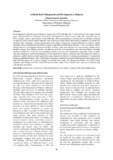| dc.contributor.author | Zainudin, Ahmad Zuwairi | |
| dc.contributor.editor | Kawamura, Hajime | |
| dc.contributor.editor | Iwata, Tsuyoshi | |
| dc.contributor.editor | Theparoonrat, Yuttana | |
| dc.contributor.editor | Manajit, Nopporn | |
| dc.contributor.editor | Sulit, Virgilia T. | |
| dc.date.accessioned | 2018-11-17T14:57:57Z | |
| dc.date.available | 2018-11-17T14:57:57Z | |
| dc.date.issued | 2016 | |
| dc.identifier.citation | Zainudin, A. Z. (2016). Artificial reefs management and development in Malaysia. In H. Kawamura, T. Iwata, Y. Theparoonrat, N. Manajit, & V. T. Sulit (Eds.), Consolidating the Strategies for Fishery Resources Enhancement in Southeast Asia. Proceedings of the Symposium on Strategy for Fisheries Resources Enhancement in the Southeast Asian Region, Pattaya, Thailand, 27-30 July 2015 (pp. 37-39). Samutprakan, Thailand: Training Department, Southeast Asian Fisheries Development Center. | en |
| dc.identifier.isbn | 9786163581600 | |
| dc.identifier.uri | http://hdl.handle.net/20.500.12067/706 | |
| dc.description.abstract | Development of artificial reefs in Malaysia started since 1975 in Kedah. The 1st artificial reefs were made of used tyres. Advancements in technology allowed the development of artificial reefs using other materials such as PVC, ceramic, culvert, and concrete. From 2006 until 2014, development of artificial reefs in Malaysia focused on specially built concrete-based materials since concrete provides better and stronger foundation to sustain the artificial reefs' functions. Various designs have been made to match the seabed conditions in order to obtain optimum effects in enhancing the fishery resources and habitat rehabilitation. Results of socio-economic studies among fishers in Terengganu indicated that 89% of fishers agree that artificial reefs development enhance their monthly income from fishing activities. In addition, artificial reefs installation also increased fishers' monthly income by RM12.45. Artificial reefs installation usually involves local communities especially fishers to make sure that planning to build and installation will be beneficial to fishers. Artificial reefs installation also helps to minimize conflicts between traditional fishers and commercial fishers by curbing encroachment of commercial fishers in traditional fishers' areas. Underwater observation conducted in several artificial reefs showed that more than 100 fish species are living or foraging in artificial reefs areas. The Malaysian Fisheries Act 1985 clearly stipulates that fishing activities within 0.5 nautical miles radius from artificial reefs areas are prohibited and considered as an offence. | en |
| dc.language.iso | en | en |
| dc.publisher | Training Department, Southeast Asian Fisheries Development Center | en |
| dc.subject | Malaysia | en |
| dc.title | Artificial Reefs Management and Development in Malaysia | en |
| dc.type | Conference paper | en |
| dc.citation.spage | 37 | |
| dc.citation.epage | 39 | |
| dc.subject.asfa | fishery economics | en |
| dc.subject.asfa | reefs | en |
| dc.subject.asfa | resource management | en |
| dc.subject.asfa | reef fisheries | en |
| dc.subject.asfa | socioeconomic aspects | en |
| dc.subject.asfa | sustainable fishing | en |
| dc.subject.asfa | resource conservation | en |
| dc.subject.asfa | Shelters | en |
| dc.subject.asfa | Habitat improvement (physical) | en |
| dc.subject.asfa | sustainability | en |
| dc.subject.asfa | Reef fish | en |
| dc.subject.asfa | artificial reefs | en |
| dc.citation.conferenceTitle | Consolidating the Strategies for Fishery Resources Enhancement in Southeast Asia. Proceedings of the Symposium on Strategy for Fisheries Resources Enhancement in the Southeast Asian Region, Pattaya, Thailand, 27-30 July 2015 | en |

